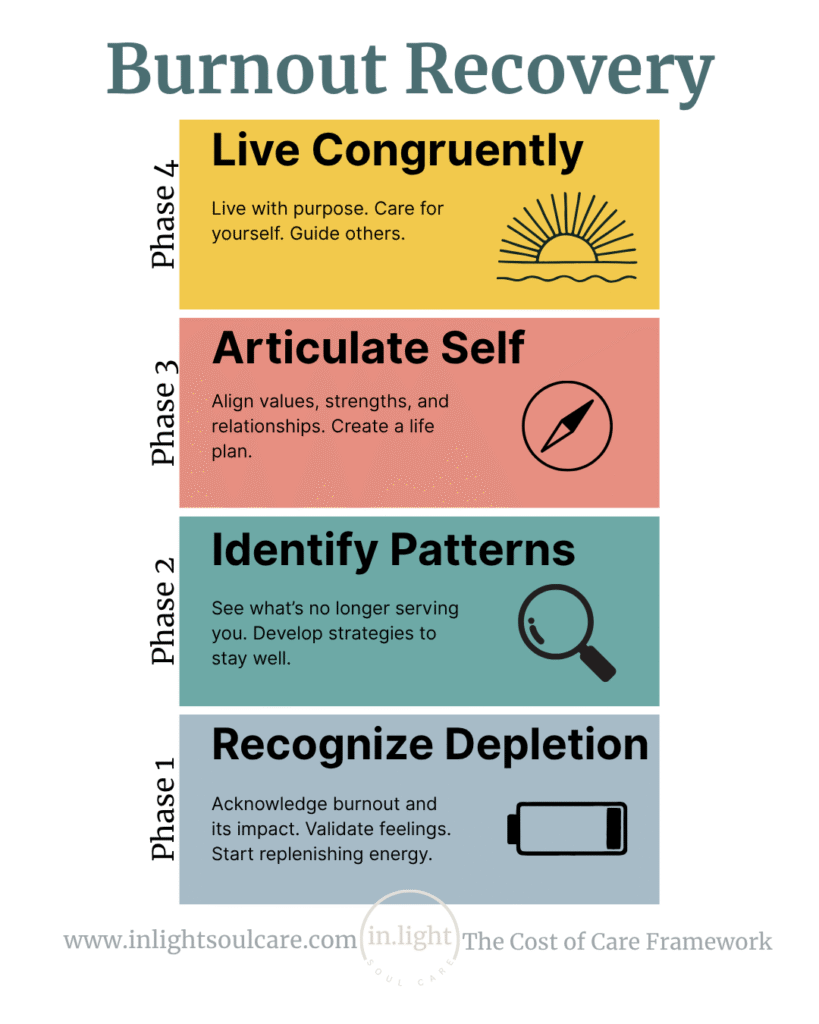3 Evidence-Based Ways to Rebuild After Burnout
Psychotherapy support to help you rebuild your identity, energy and trust in yourself after burnout.
Burnout is healed with science-backed strategies. Learn the 3 research-proven methods that helped me rebuild after burnout and recover as a pandemic chaplain. From nervous system repair to challenging workplace myths, therapists, first responders, and high-stress professionals need this understanding as a guide.
When I hit burnout as a chaplain in the pandemic, I felt hollow. The kind of exhaustion that makes your bones ache and your thoughts blur. I’d sit in my car after shifts, staring at the steering wheel, wondering how I’d drag myself home. Bubble baths and scented candles? They wouldn’t have touched the edges of what I was feeling.
Burnout is a systemic collapse of your nervous system, your sense of purpose, your ability to care. And to rebuild after burnout requires intentionality.
Here’s what helped me recover, backed by research and hard-won experience:
1. Therapy Reconnected Me
During the pandemic, I was able to spend more time with 2 of my supervisors: who were both trained therapists who didn’t ask me to “practice more self-care.” Instead, they helped me get in touch with my inner passions and sense of self. Those questions were the sparks that changed so much. Burnout had erased my ability to recognize my own joy, my humor, my capacity to feel anything but numb.
Research from the University of California shows that short-term, flexible therapy significantly reduces burnout by restoring fulfillment—not just reducing symptoms. Their pilot study found that residents who engaged in therapy reported increased self-compassion, quality of life, and professional fulfillment. The key? Therapy was about reclaiming agency.
Here’s what we learn:
We can seek therapists trained in supportive, non-pathologizing approaches.
Explore deeper questions like, “What parts of me did burnout silence that I need to reclaim?”
2. Redefine “Recovery” as a Workplace Issue
For months, I blamed myself: If I were stronger, more resilient, better at boundaries… But there’s a study on Finnish burnout rehabilitation (Korhonen & Komulainen, 2021) that exposes a dangerous myth: Burnout is often framed as an individual failure, when it’s usually a systemic one.
The researchers analyzed health professionals’ discourses and found most interventions focused on changing the person by teaching assertiveness, self-care and mindfulness while ignoring toxic work conditions. But the participants who recovered sustainably were those who challenged this narrative, demanding workplace adjustments (like reduced hours or clearer role boundaries).
Try this:
Audit your work environment: Are your burnout “solutions” only targeting you?
If possible, advocate for structural changes (delegation, workload audits, mental health leave). If not, name the gap because it’s not your fault the system is broken.

3. Rebuild Your Nervous System
Burnout shows up in your body. The UofC study highlighted that residents who recovered fastest integrated somatic practices.That means listening to your shaking hands, clenched jaw, and insomnia.
Research on how to rebuild after burnout and neurobiology factors shows chronic stress shrinks the prefrontal cortex (the “thinking” brain) and hyperactivates the amygdala (the “fear” brain). To heal, you need to signal safety to your nervous system.
Try this:
Physiological sighs: Double inhale through the nose, long exhale through the mouth. (This resets your autonomic nervous system within minutes.)
Workday anchors: A 60-second stretch between meetings, a walk outside without your phone. Tiny pauses train your body it’s safe to rest.

The Truth About Rebuilding
To rebuild after burnout is to honouring the depth of your exhaustion and make room for the resilience still flickering beneath it.
This is why I developed my 4-phase recovery framework I call The Cost of Care. Learn more about it here:

If you’re struggling with burnout or emotional exhaustion, I offer online therapy across Ontario for helping professionals. Book a Free 20 minute Consultation Here.
Sources:
Zisook et al. (2025). The Association of Psychotherapy With Burnout, Depression, and Measures of Well-Being in Residents and Fellows.
Korhonen & Komulainen (2021). Individualizing the Burnout Problem: Health Professionals’ Discourses of Burnout and Recovery.














